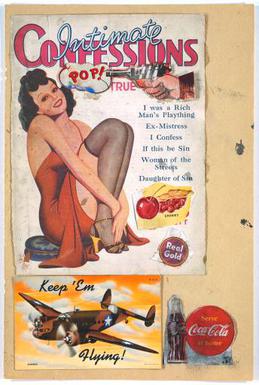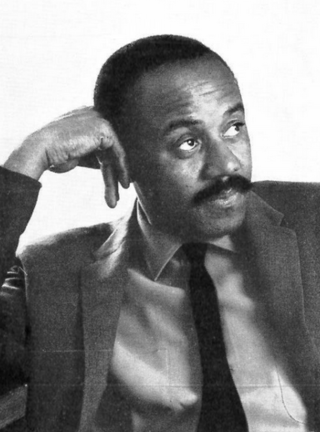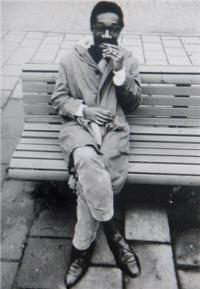
Pop art is an art movement that emerged in the United Kingdom and the United States during the mid- to late-1950s. The movement presented a challenge to traditions of fine art by including imagery from popular and mass culture, such as advertising, comic books and mundane mass-produced objects. One of its aims is to use images of popular culture in art, emphasizing the banal or kitschy elements of any culture, most often through the use of irony. It is also associated with the artists' use of mechanical means of reproduction or rendering techniques. In pop art, material is sometimes visually removed from its known context, isolated, or combined with unrelated material.

Leo Castelli was an Italian-American art dealer who originated the contemporary art gallery system. His gallery showcased contemporary art for five decades. Among the movements which Castelli showed were Surrealism, Abstract Expressionism, Neo-Dada, Pop Art, Op Art, Color field painting, Hard-edge painting, Lyrical Abstraction, Minimal Art, Conceptual Art, and Neo-expressionism.

The Gagosian Gallery is a contemporary art gallery owned and directed by Larry Gagosian. The gallery exhibits some of the most influential artists of the 20th and 21st centuries. There are 16 gallery spaces – five in New York City, three in London, two in Paris, and one each in Basel, Beverly Hills, Rome, Athens, Geneva and Hong Kong.

Campbell's Soup Cans is a work of art produced between November 1961 and June 1962 by American artist Andy Warhol. It consists of thirty-two canvases, each measuring 20 inches (51 cm) in height × 16 inches (41 cm) in width and each consisting of a painting of a Campbell's Soup can—one of each of the canned soup varieties the company offered at the time. The works were Warhol's hand-painted depictions of printed imagery deriving from commercial products and popular culture and belong to the pop art movement.
The Bodley Gallery was an art gallery in New York City, from the late 1940s through the early 1980s. The Bodley specialized in contemporary and modern art. David Mann was director of the gallery during its heyday and Mr. and Mrs. Raymond Braun, were the owners.

Marco Sassone, OMRI is an American-Italian painter. He moved to Florence in 1954, where his interest in painting began. He studied architectural drafting at the Istituto Galileo Galilei, and sold his first works, watercolor sketches, to tourists. Sassone studied with painter Silvio Loffredo, who had been a pupil of the Austrian artist Oskar Kokoschka. These artists formed Sassone's early influences.
Alberto Magnelli was an Italian modern painter who was a significant figure in the post war Concrete art movement.
Max Protetch is an American dealer of contemporary art and architecture and founder of Max Protetch Gallery, New York City.

Tania was a Polish-born Jewish American abstract painter, sculptor, collage artist and painter of city walls.
Jane Fortune was an American author and journalist. Many of her publications and philanthropic activities were centered on the research, restoration, and exhibition of art by women in Florence, Italy.

Robert Hawkins is an American artist born in Sunnyvale, California, USA and presently lives in London, UK., Hawkins' is best known for his "ferocious" style of realism. His first drawing in a publication appeared in the kid's section of the San Francisco Chronicle at the age of 5.

Ellen Powell Tiberino (1937-1992) was an African American artist who was figurative and expressionist in her pastels, oils, pencil drawings and sculptures. Her works were infused with the experiences and history of Black people, women in particular, whom she most often painted in dark and haunting hues. She was a prolific artist, working against time as she battled cancer for the last 14 years of her life.
Enid Bell Palanchian, known professionally as Enid Bell in her early career and later on as Enid Bell Palanchian, was an American sculptor, illustrator and teacher born in London, England.

Walter Henry Williams Jr. (1920–1998) was an African American-born artist, painter, printmaker and ceramicist who became a Danish citizen later in his life. The subjects of his artwork evolved from urban street scenes straight out of his New York upbringing to the metaphorical images of rural Black children playing in fields of sunflowers, butterflies and shacks.
William "Bill" Lowell Howell was a graphic designer, painter, illustrator, set designer and photographer. He was an early member of the Weusi Artist Collective, a group of artists who helped birth the Black Arts Movement in the 1960s. He was art director for The New Lafayette Theatre in New York and its Black Theater magazine. He co-founded the Pamoja Studio Gallery in New York in 1967.

Samuel Joseph Brown Jr. (1907–1994) was a watercolorist, printmaker, and educator. He was the first African American artist hired to produce work for the Public Works of Art Project, a precursor to the Work Progress Administration's Federal Art Project. Brown often depicted the lives of African Americans in his paintings. He worked primarily in watercolor and oils, and he produced portraits, landscapes and prints.

Roland Ayers (1932–2014) was an African American watercolorist and printmaker. He is better known for his intricate drawings – black-ink figures of humans and nature intertwined in a dream-like state against a neutral backdrop. A poet and lover of jazz and books, he expressed his poetry through images rather than words, he often noted, and considered his artwork to be poetry.

Benjamin Franklin (Ben) Britt (1923–1996) was a figurative, surrealist and abstract painter, and art teacher. His subjects were African American culture, religion and children, which he captured in oil and charcoals. Britt signed his works “B. Britt,” dotting the “i” with tiny round circles.
Reba Dickerson-Hill was a self-taught Philadelphia artist who painted in the ancient Japanese ink-and- brush technique called sumi-e. She was also a watercolorist and oil painter who primarily produced landscapes and portraits.

Colin Greenly (1928–2014) was a visual artist active in the United States during the late 20th century and early 21st century.













